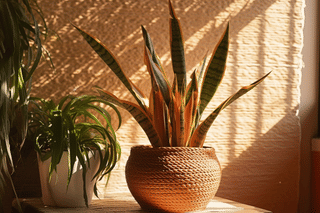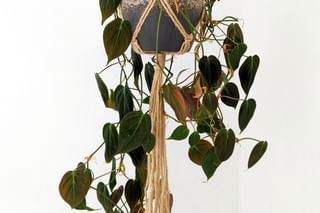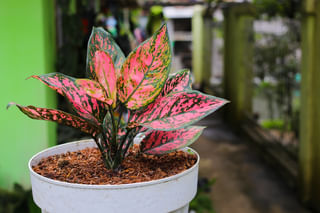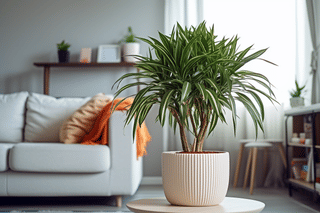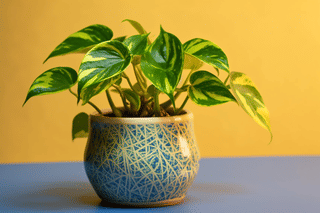Top 10 Low Maintenance Houseplants for Beginners
Discover the perfect low-maintenance houseplants for beginners and busy people with this expertly curated guide! Get ready to explore the top 10 resilient plants that will bring life and beauty into your home effortlessly. Let's dive in and cultivate your love for plants together!
If you're looking to breathe some life into your living space but are concerned about the time and effort involved, you're in the right place. In this plant care guide, we'll look at the top 10 low-maintenance houseplants perfect for beginners and people that are just busy. These easy-to-care-for plants not only add a touch of nature to your home but also offer various health benefits like purifying the air and boosting your mood.
These are the 10 low-maintenance houseplants we're going to look at in this guide:
Whether you're a busy professional, a student with little free time, or someone who forgets to take care of your plants, this guide is for you. Let's explore low-maintenance plants that look great and take minimal effort!
String of Hearts
The String of Hearts, or Ceropegia woodii, is a charming trailing plant with cascading vines of heart-shaped leaves. This lovely plant adds a whimsical touch to any space and thrives with minimal care, making it ideal for beginners or those with a busy lifestyle.
Caring for the String of Hearts plant is a breeze. It loves bright, indirect sunlight, although it can also tolerate partial shade. Watering should be minimal. Let the soil dry out completely before watering again to avoid root rot. This plant is drought-tolerant, so it's better to under-water than over-water.
To keep it healthy, plant it in a well-draining potting mix to ensure the roots don't sit in soggy soil. No need for frequent fertilization; feeding it once every two months during the growing season (spring and summer) is enough.
Intrigued by the easy-care String of Hearts? Want to discover more about this charming plant and how to keep it thriving in your home? Visit my detailed plant care guide for a comprehensive guide to caring for a String of Hearts.
Snake Plant (Sansevieria)
The Snake Plant, also known as Sansevieria, is a fantastic addition to any indoor garden. This plant is THE symbol of endurance and resilience and is not just loved for its unique, upright, sword-like leaves, but it's also well-known for being almost impossible to kill. The Snake Plant thrives under most conditions and is amazingly hardy, making it the perfect choice for those new to plant parenting.
Caring for the Snake Plant is straightforward. It needs bright, indirect light, but will tolerate low-light conditions. In terms of watering, be careful not to overdo it. Allow the soil to dry out completely between waterings, as the plant is prone to root rot if left in waterlogged soil.
The Sansevieria needs very little fertilizer and should only be fertilized a few times per year. Snake Plants are also tolerant of a wide range of temperatures, making them the perfect low-maintenance plants to add to your indoor plant collection.
Are you conviced by the tough Sansevieria? Want to learn more about how to care for this tough houseplant? Visit my guide about the sansevieria for an in-depth care guide.
ZZ Plant

The ZZ Plant, known formally as Zamioculcas zamiifolia, is the superstar of the low-maintenance plant world. With its glossy, green leaves, the ZZ Plant is a stylish, and nearly indestructible plant to add to your home or office.
Some also call this plant the "Eternity Plant," because it's famous for its ability to survive under almost any conditions. This plant is a dream come true for beginners or busy individuals who want a touch of greenery that won't need a lot of your time.
Caring for a ZZ Plant is incredibly easy. It requires low to moderate light, making it an ideal plant for spaces with very little natural light. You should water it very little. Let the soil dry out completely between waterings, as overwatering can lead to root rot.
The ZZ Plant is not fussy about humidity and can thrive in the dry air of heated homes during winter. As with other low-maintenance plants, it doesn't need to be fertilized very often: once in spring and once in summer should be enough.
With its minimal care requirements, the ZZ Plant is the perfect green companion for those who are new to plant care or often away from home.
Want to grab one for your home or office but unsure how to care for it properly? Don't worry! Head over to this comprehensive guide to learn more about how to keep your ZZ Plant thriving with minimal effort.
Spider Plant

Get ready for the Spider Plant, a classic favorite that looks like its nickname! This easy-going plant is known for its arching foliage and unique-looking growth. Don't be fooled by its delicate appearance, the Spider Plant is as tough as they come and requires very little attention to thrive.
The Spider Plant, officially known as Chlorophytum comosum, enjoys a well-lit spot but also thrives in low-light conditions. While it prefers well-drained soil, it is quite forgiving if you accidentally overwater it. The most important part is to let the soil dry out between watering.
The spider plant doesn't do too well in heat and prefers cooler temperatures, making it a great indoor companion. Like the other plants, you won't need to fertilize very often, just a couple of times a year in spring and summer should do the trick.
The Spider Plant is pretty low-maintenance, making it a great choice for beginners or those with a hectic schedule. Want to know more about this resilient houseplant? Visit this comprehensive plant care guide to delve deeper into taking care of this incredible houseplant.
Sedum Morganianum

Meet the Sedum Morganianum, more commonly known as the Burro's Tail or Donkey's Tail. This stunning succulent, with its long, trailing stems and plump, green leaves, is almost too easy to take care of! The Burro's Tail is one of the most low-maintenance houseplants out there, making it a great choice for beginners or anyone with a busy schedule.
This Sedum is an easy-going plant. It likes to grow in bright light but can also do well in partial shade. When it comes to watering, less is more. Let the soil dry out completely before giving it another drink to prevent the roots from getting too soggy.
The Sedum isn't picky about humidity and can handle dry conditions. You only need to feed it with fertilizer a couple of times during the growing season. This plant is perfect if you're looking for a low-maintenance houseplant that will catch your eye every single time!
Looking for more in-depth guidance on how to care for this charming, low-maintenance houseplant? Visit this in-depth plant care guide to learn more about taking care of this tough houseplant.
Philodendron Micans
Now we're looking at one of my all-time favorite low-maintenance houseplants! The Philodendron Micans, a houseplant that is as easy-going as it is beautiful! This lush, leafy plant is a real crowd-pleaser with its stunning, heart-shaped leaves, and best of all, it's very low-maintenance.
The Philodendron Micans isn't picky. It enjoys bright, indirect light but can survive in low light too. Be sure not to overwater, waiting until the top inch of the soil is dry before watering again. It doesn't need much fertilizer, just a little in spring and summer is plenty. This plant is great if you're new to gardening or have a busy schedule.
My favorite part of this amazing houseplant is the color of its leaves and the unusual velvety texture of its leaves! Are you excited to learn more about this houseplant? Have a look at this detailed plant care guide and learn how to take excellent care of it!
Aglaonema (Chinese Evergreen)
The Aglaonema, or as it is commonly known, the Chinese Evergreen is a very tough, but beautiful addition to your indoor garden. It's famous for its variegated leaves that come in a blend of green, cream, and sometimes even red hues. This plant can thrive in almost any indoor condition.
The Aglaonema is a star performer among low-maintenance houseplants, as it needs very little care but gives you incredible looks in return. If you've always wanted a houseplant that combines toughness and beauty, then the Chinese Evergreen is ideal for you.
The Aglaonema is very adaptable when it comes to light conditions. It can tolerate low light but does best in bright, indirect light. Like the other plants, you won't have to water it too often. Just make sure the top soil is dry before watering it, and reduce watering during the cooler months.
This plant is not picky about humidity, so it's perfect for homes with dry indoor air. Fertilize your Aglaonema a few times a year, particularly during the growing season, to keep it happy and healthy.
Want to explore more about taking care of the Aglaonema? Click here for a comprehensive guide on how to care for your Chinese Evergreen, and make the most of your indoor gardening experience with this low-maintenance houseplant.
Dracaena
The Dracaena has a special place in my heart as it was my first "big" houseplant. More than 4 years later and it's still healthy and takes very little time and effort. This plant, also known as the 'Dragon Tree," is perfect for those of you who appreciate the minimalistic and timeless look of this plant, but don't have too much time to take care of it.
The Dracaena is all about delivering maximum aesthetics with minimum upkeep, making it the ideal choice for beginner plant enthusiasts or anyone with a tight schedule. Let's dive in to learn more about this low-maintenance houseplant superstar!
The Dracaena thrives best under indirect, medium light but can also tolerate low light conditions. Overwatering is the easiest way to kill this plant, so be sure to avoid this at all costs. Allow the top layer of the soil to dry before watering again, and use less water during the colder months.
As for humidity, the Dracaena is very flexible, and it can handle most indoor conditions. You might wonder if you need to fertilize this plant and the simple answer is, it's helpful, but not necessary. If you do want to feed it, you can do so once per month in the growing season.
Are you excited to bring this majestic, low-maintenance houseplant into your life? Visit this detailed plant care guide and learn how to take care of your Dracaena with ease!
Jade Plant

Are you ready for a unique succulent? Have a look at the Jade Plant! It's known for its thick, shiny, dark green leaves that resemble beautiful jade stones. The Jade Plant is not just a great-looking plant! It's also one of the most low-maintenance houseplants you can find. Let's look at some of its care requirements.
The Jade Plant is a succulent that likes a sunny spot but can also tolerate some shade. You should only water it when the soil has dried out completely. Overwatering can lead to root rot, so it's best to water it too little than too much.
It's also not difficult when it comes to humidity and can thrive in most average homes. When it comes to feeding, a bit of diluted fertilizer during the growing season will be all it needs for the year. If you're looking for a low-maintenance houseplant that still adds a touch of beauty to your home, the Jade Plant is an excellent choice.
Want to learn more about the easy-care Jade Plant? Dive into my in-depth guide for a comprehensive rundown on how to keep your Jade Plant healthy and thriving.
Pothos
The Pothos is well-known for its stunning, heart-shaped leaves and its impressive adaptability. It's a perfect choice for beginners , because this plant care recover from neglect very quickly and it's easy to take care of. However, this plant is not just easy to care for but is also an excellent choice if you want to create a low-maintenance indoor jungle. Let's discover more about this low-maintenance houseplant.
The Pothos plant prefers bright, indirect light but can also thrive in low light conditions or artificial light, making it an excellent option for offices or apartments with little natural light. If you don't have a lot of time to water your Pothos, you're in luck! This plant only needs to be watered when the top inch of the soil feels dry. The pothos stores quite a bit of moisture in its vines, so it's fine to let it dry out for a few days too.
The Pothos is not particularly picky about humidity and can handle most average indoor conditions. As for feeding, a light application of a balanced houseplant fertilizer every two months during the growing season will be enough for it.
Ready to dive deeper into the world of Pothos care? I invite you to visit my detailed plant care guide for more information on how to take care of your Pothos. Let's help your indoor jungle thrive with minimal effort!
Conclusion
Taking care of houseplants doesn't have to be a difficult or even time-consuming hobby. All of the plants that we've looked at are stunning, low-maintenance houseplants that make your house look incredible without costing a lot of time. So why wait? Get started on your indoor gardening journey with these hassle-free houseplants!
Thank you for reading this post! I hope it helps you to keep your plants healthy and beautiful! If you're looking for more guides on specific plants, you can always request a plant guide to get a guide for the plant you have trouble with.
Test your plant care knowledge
Quiz completed!
Want to learn more? Sign up for my newsletter to receive free tips in your inbox!
Sign up now!

